
Bibi Ka Maqbara
Treasured on the international front as the minuscule model of the Taj Mahal of Agra, the Bibi Ka Maqbara of Aurangabad is a catacomb constructed by Aurangzeb’s son Azam Shah in 1660 AD as a tribute to his loving mother; Dilras Bano Begum. Also known by the moniker ‘Rabia-ud-Durrani’, Dilras Bano Begum was the first wife of the notorious Mughal Emperor Aurangzeb. Commended as the most prominent landmark of the city, Bibi Ka Maqbara is located nearly 6 kilometers away from the Aurangabad Railway Station. Honored by the title; the ‘Dakkhani Taj’ (i.e. the Taj of the Deccan) and also reckoned as the ‘Poor Man’s Taj’, the Bibi Ka Maqbara is a brilliant epitome of the gradual transit of architectural orders from the ostentatious and showy architecture of Akbar and Shah Jahan to the unpretentious and simple style of the successive Mughal emperors. The term Bibi Ka Maqbara literally means the ‘Tomb of the Lady’.Supposed to be raised at the expense of about 7 lakh rupees, this hexagon shaped cenotaph is ornamented with elaborately festooned minarets. Designed by a prolific Mughal Architect Ata Ullah and built in sandstone and shiny white marble stone, the Bibi Ka Maqbara is applauded as the only archetype of Mughal architecture of its kind in the entire Deccan plateau. Bejeweled with baroque stockades and crowned with lustrous marble dome, this reminder of long-gone age flamboyantly stands amidst the verdant lawns of a finely landscaped garden. The main crypt of the memorial where the mortal remains of Dilras Bano Begum lay buried is illustrated by splendid surface embellishments and elegant marble screens. The garden ornamenting the façade of the Maqbara is in itself decorated with a central pond, fountains, water channels, lofty pavilions and broad pathways.
The tourists can pay a visit to the Maqbara from 8:00 am to 6:00 pm every day and Rs. 10 are charged as the entry fee here.

Ajanta Caves
Sited near the town Ajanta (Ajintha) about 96 kilometers from Aurangabad in Aurangabad District, the Ajanta Caves are a bouquet of 30 rock cut caves dating back to 2nd century BC to 6th century AD. Acknowledged as the embodiment of Buddhist religious art, the Ajanta Caves delineating the Buddhist and Sigiriya pictures, sculptures and frescos were listed amongst the UNESCO World Heritage Sites since 1983. Estimated to be created during the Satvahana or Vaktaka ascendancy, this horse shoe shaped framework of Ajanta caves stayed obscured until 28th April 1819 when a British officer of the Madras Presidency named John Smith rediscovered them. Cave no 1, 2 and 4 are the most striking caves highly eulogized for their outstanding set up, incomparable architecture and their extraordinary historical magnitude.Cave no 1 is praised pole to pole for its magnificent figure of Lord Buddha portrayed in the seating posture and holding his hands in the Dharmachakrapravartana Mudra. Apart from that, the interior walls of the cave 1 depict the stories from the Jataka Tales as well as the life and deeds of Lord Buddha. Cave no. 2, except for its representations of the Jataka Tales and the incidents from the life of Lord Buddha, is also famed for its human, divine, semi divine, animals, ornamental and erotic motifs. Cave no. 4 is extolled for the gigantic image of Lord Buddha seated in the preaching position. This effigy can be seen flanked by the Bodhisatvas and the celestial nymphs hover above the head of Lord Buddha here.

Ellora (Verul) Caves
Also deemed as the UNESCO World Heritage Site, the Ellora Caves (Verul Caves) are to be found at the distance of about 29 kilometers to the North West of Aurangabad in the Maharashtra State. This garland of 34 caves fundamentally carved out of the upright face of the Charanandri hills is accredited with the honor of being a paramount manifestation of vital Indian rock-cut architecture. Dated back to the period between 5th and 10th century AD these caves are presumed to be built during the domination of Rashtrakuta kings. Featuring the Buddhist, Hindu and Jain rock-cut temples, mathas and viharas, this cluster of rock cut caves proffer the extraordinary religious harmony prevailing during that age of ancient India.There are 12 Buddhist, 17 Hindu and 5 Jain caves. Most of the Buddhist caves adorned with arresting carvings of Lord Buddha, Bodhisatva and various Buddhist saints mainly comprise of the Viharas, living quarters, kitchens, sleeping rooms and other quarters. Cave no 10, also known as the ‘Vishvakarma Cave’ or the ‘Carpenter’s Cave’ is the most aggrandized amongst all the Buddhist caves of Ellora that is particularly noted for its giant ‘Chaitya Hall’. The most distinctive feature of this cave is that the sculptures are chiseled in such a manner that stones generate the semblance of wood. Moreover, this cave is also reckoned for its 15 foot tall statuette of Lord Buddha seated in the preaching posture.
The most striking attributes of the Hindu caves of Ellora include the Kailasanathar Temple in the cave no 16 and the Dashavatara sculptures of cave no 15. Other Hindu caves of Ellora are Rameshwara Cave (21), Dhumar Lena (29), Ravan ki Khai (14) and Nilkantha cave (22). The Jain caves of the Ellora Cave Complex belonging to the Digambara sect of Jainism disclose the Jain ideology and philosophy. The most crucial Jain caves are Chhota Kailash (30), Indra Sabha (32) and Jagannath Sabha (33). The Indra Sabha Cave is primarily celebrated for its impressive sculpture of Yaksha, dainty carvings of lotus flower, an appealing image of Ambika and a sculpture of a Matanga seated on an elephant.

Aurangabad Caves
Positioned atop a mount in the Sihaychal ranges nearly 2 kilometers away from the Bibi Ka Maqbara, the Aurangabad Caves is a cave complex of 12 rock-cut Buddhist Caves. Divided into two categories; eastern and western and recognized amongst the preeminent acquisitions of Indian Classical Art, these Buddhist caves are estimated to be put up between 2nd and 7th century AD. The profound sculptures and carvings of Aurangabad Caves are weighed against the best paintings of the world famous Ajanta and Ellora caves. Chiseled out of soft basalt rock, the architecture as well as the iconography of these caves projects the clear Tantric influence. The most notable caves of this cave complex include the caves numbered 3, 4 and 7.The cave no 3 is famed for its fabulous motifs of flowers, scrolls, tassels, fretwork, panel of couples and a wide range of geometrical designs. The cave no. 4 suspended upon 12 brilliantly carved pillars depicts the occurrences from the Jataka Tales and the cave no 7 depicts the carvings of women wearing dazzling ornaments. The sculpture of Lord Bodhisattva praying for salvation is the most noteworthy feature of cave no 7. Situated overlooking the Dr. Babasaheb Ambedkar Marathwada University Campus of Aurangabad, the Aurangabad caves are also noted for offering the spectacular panorama of the entire Aurangabad city.
Outshined by the UNESCO World Heritage Monuments of Ajanta and Ellora caves, the Aurangabad Caves were illustrated by the scholars as the “sensitive remaking of life situated in time and space”. These caves can be visited from 9:00 am to 5:00 pm. An entry fee of Rs. 10 is charged here.

Ghrishneshwar Temple
Dedicated to Lord Shiva and regarded as one of the 12 Jyotirlingas of India, the Ghrishneshwar Temple is located just half a kilometer away from the Ellora Caves and about 31 kilometers away from Aurangabad. Believed to be erected between 1765 and 1795 AD under the patronage of Maharani Ahilyabai Holkar of Indore, this Shiva Temple is constructed out of red volcanic stone. Featuring its imposing 5 tier dome (shikhara) escalating in retreating height, the Ghrishneshwar Temple proposes an unprecedented exemplar of the architectural and sculptural adroitness of the artisans of yesteryears. Each of the 5 shikharas crowned with a sculpture of a Nandi and a monkey is decked with sumptuous arithmetical patterns and eloquent images of Hindu deities including Lord Siva and Goddess Parvati.The structural design of the Ghrishneshwar Temple introduces a fine fusion of ancient and contemporary Indian temple styles and absolutely departs from the then prevalent Islamic fashion of temple architecture. The façade of the temple bears ostentatious statuettes of Dashavataras ornately carved in the red sandstone. The Sabha Mandapa that leads to the sanctum is held up by 24 skillfully festooned pillars and houses a huge Nandikeshwara Idol. The small Garbhagriha (sanctorum) of the temple enshrines a glorious Shiva Lingam that is installed facing east (Purvabhimukh). As cited in the Hindu scripture Shivpurana, Lord Shiva revived the dead son of Ghushma (also known as Kusuma) at this place and on her request agreed to reside here as Lord Ghrishneshwar everlastingly.
Lord Ghrishneshwar is the presiding deity of Ellora Town and a great annual fair is organized at the temple on the auspicious occasion of Mahashivratri.

Jumma Masjid
Jumma Masjid or ‘Jama Masjid’ of Aurangabad situated close to the legendary Quila-E-Ark was constructed by Malik Ambar in the year 1612 soon after the establishment of Aurangabad. Later refurbished and extended by the Mughal Emperor Aurangzeb in 1692 AD, the Jumma Masjid is one of the oldest mosques of Aurangabad still preserved in a fairly good state. The most notable trait of the Jumma Masjid is its 50 polygonal pillars arranged in 5 rows. All these pillars interconnected with a system of 9 channeling arches divide the whole structure into 27 equivalent sections. Each of these sections is topped with a small elegantly designed spherical dome. Out of the 9 sharp arches that ornament the frontispiece of the mosque, 5 were formerly raised by Malik Ambar whereas the remaining 4 were subsequently added by Aurangzeb. A sizeable courtyard built at the front of the mosque bears open edifices on 3 sides where in ancient times the voyagers used to make a night halt. A water tank is put up at the center of the courtyard which is filled by the water channeled from the Malik Ambar canal.
Shahganj Masjid
Stationed in the great market square of Aurangabad along the post office road adjacent the Shahganj Park near the Shahganj Railway Station, the Shahganj Masjid happens to be one of the nonpareil constructions of its sort ever sited in any part of India. Believed to be kicked off in 1720 AD under the benefaction of Sayyad Husain Ali, the Shahganj Mosque was later completed and extended by Aazu-d Daula Iraz Khan. Erected on a lofty platform, the Shahganj Mosque Complex accommodates numerous shops on three of its external sides while the forth side is open from where a flight of stairs leads us inside the mosque. The entrance of the Shahganj Mosque also designed in a small mosque like pattern is decorated with a pointed arch and two imperial towers. The internal portion of the Shahganj Masjid consists of 24 columns out of which 6 columns form a pattern of a square. Two large water reservoirs are built at the frontage of the court-yard where visitors quench their thirst and also wash their hands and feet before entering the mosque. Revered by the Muslim devotees and equally esteemed by the tourists due to its religious, historical and architectural magnitude, the Shahganj Masjid; a paradigm of Indo-Sarcenic architecture is one of the must visit tourist attractions of Aurangabad.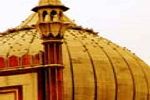
Chowk Masjid
Exceedingly frequented by the devotees as well as the tourists all round the year, the Chowk Masjid of Aurangabad parked in the City Chowk area near the Adalat Road is yet another epitome of Islamic architecture existing in India. Founded under the sponsorship of Shayista Khan; the maternal uncle of Aurangzeb in the year 1665, this mosque apart from its momentous architectural grandeur, also boasts of its elongated life history. The front outlook of the Chowk Masjid is embroidered with five pointed arches interconnected by eight corresponding porticos that uphold the five cupolas of the mosque. The uprisen central dome is embellished with a metallic tower while the rest of the domes are cloaked under the main roof of the Masjid. The corners of the Chowk Masjid are adorned with intricately carved minarets that create an utterly breathtaking prospect.
Dargah of Pir Ismail
The Dargah of Pir Ismail is a cenotaph established as a mark of homage towards the revered memory of Baba Pir Ismail; a well-known saint and seer of bygone era who acted as the tutor and the spiritual instructor of Prince Aurangzeb before he ascended the throne of the great Mughal Empire in India. Particularly characterized with idyllic and tranquil ambience that is perfect for unwinding, the Dargah of Pir Ismail one of the effulgent remnants of the magnificent antiquity of Aurangabad is a greatly haunted heritage destination of this historical city. The main entrance of the Dargah bejeweled with a massive pointed archway renders a genuinely ceremonial aura to the entire edifice while the garden that encloses the mausoleum is noted for preserving the ruins of a number of ancient water ponds and fountains. At present, the main entrance doesn’t function as the actual entryway but the Dargah Complex can be accessed only through a small archway positioned at the far end of the Dargah. The Dargah of Pir Ismail, square in its shape is furbished with pointed arches on all four sides while a giant dome crowns the central quarters of the structure. Furthermore, the Dargah is also bedizened with three small arched windows and a gracefully designed Parapet.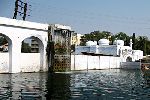
Panchakki
‘Panchakki’ is a Marathi term which means ‘watermill’. Located about 3 kilometers away from the Aurangabad Railway Station close to the Aurangabad Textile Mills amidst a garden sited right next to the Mahmud Darwaza, the Panchakki of Aurangabad is a testimonial of the scientific and technical advancement achieved during the medieval era. Basically this watermill was designed to produce power from the cascading spring of water gushing down a nearby mountain. Constructed in the year 1695 AD under the commands of Turktaz Khan; a noble in the court of Nizam-ul-Mulk Asaf Jah, this watermill was employed in generating energy which was used to turn the large grinding stones of the nearby flourmill. This flourmill was engaged in grinding grains for the meals of the saints, disciples, soldier troops and the pilgrims alighted here to pay a visit to the adjoining Dargah of Baba Shah Musafir. The left over water was later let into the Kham River. Other than the watermill, the Panchakki Complex also accommodates a mosque, a Dargah, a madrissa, a sarai, a kacheri, a minister’s house, zanana enclosure, and also the headquarters of the Wakf board of Maharashtra. An ancient library dated back to 18th century AD has currently been reopened at the Panchakki Complex after a gap of almost 70 years. This library houses more than 100,000 precious manuscripts and valued books dated till the period of the Independence of India.
Soneri Mahal
Also commonly known as ‘Sunheri Mahal’, the Soneri Mahal is an architectural wonder of Aurangabad to be found within the premises of the Dr. Babasaheb Ambedkar Marathwada University Campus. Built in stone and lime in 17th century AD under the guardianship of a Bandalkand Chief who had came to the Deccan Plateau with Aurangzeb, the Soneri Mahal palace derives its title after an ancient painting. This painting was painted in gold and was found in the manor house of this erstwhile royal fortress. The term ‘Soneri’ or ‘Sunheri’ Mahal means the ‘golden palace’. As soon as you cross the doorsill of the Soneri Mahal, you will see an imposingly landscaped garden ornamented with lush green lawns. A quadrilateral water reservoir that is vertically extended from the entrance towards the Soneri Mahal divides the garden into two sections. Now converted to a heritage museum, the Soneri Mahal is an incredible memento of the majestic Mughal Era.The Soneri Mahal Museum exhibits a wide range of historic and archaeological items including old statues, remains of the local palaces, sculptures, excavated reliefs, pottery items, coins, daily use antiques, apparels, ancient manuscripts, and so on. Besides, the palace also houses a library where historical books and manuscripts are preserved. Once possessed by King Bundela Veer Hardaul from Madhya Pradesh, the Soneri Mahal is an embodiment of everlasting glory of the Mughal Era. For last few years the Soneri Mahal has been hosting the highly exalted Ellora-Ajanta-Aurangabad cultural festival. A number of prominent Indian artists who have excelled on the global front in Indian music and dances such as Ustad Jhakir Husain, Pandit Hariprasad Chaurasiya etc. perform at this prestigious festival that continues for three days. Tourists can pay a visit to the Soneri Mahal of Aurangabad from 8:00 am to 6:00 pm. Rs 10 is charged as the entry fee here.

Damri Mahal
Recognized by the name the ‘Revenue Office Building’ at the moment, the Damri Mahal of Aurangabad is a historical structure constituted following the completion of the renowned ‘Barra Darri’. The Damri Mahal was built from the funds forcefully collected from the laborers and craftsmen who were appointed at the construction site of the Barra Darri. As this imposed donation equated the amount of a ‘Damri’ i.e. a quarter of a dub, this building was named the ‘Damri Mahal’. This flamboyant structure yields a truly staggering prospect as the frontage of this framework is decked out with an arched terrace garlanded with five cloisters. To the opposite side of the terrace ten rooms of different sizes are built in a straight linear order while numerous compartments are placed to the right of the Damri Mahal. The domed roof of this ziggurat proffers the entire configuration a truly aristocratic look. The Damri Mahal, one of the must visit historical edifices of Aurangabad is certainly a personification of artistic dexterity and architectural adroitness of yesteryears.
Quila-E-Ark
Quila-E-Ark (or Killa Arrak) a royal alcazar of Aurangabad was built in the year 1692 under the patronage of the great Mughal Emperor Aurangzeb. Positioned in close proximity to the Himayat Bagh garden of Aurangabad, the Quila-E-Ark enclosed more or less the total space between the Mecca Gate and the Delhi Gate of Aurangabad. Enriched by sturdy fortifications, this garrison is reinforced by six gates in total, one of them being the famous Kaala Darwaza. Although in ruins today, the fortifying battlements of the Quila still depict the remains of their looped semi globular towers onto which guns were mounted in olden days for the defense purposes. The interior security walls of the palace hold recesses which are put up at regular intervals. These recesses bear a resemblance to the oriels found in the city walls. To the right of the main entrance an elevated terrace has been built which pulls out the complete length of the enclosing ground. In addition to that, this stronghold also houses a nagarkhana where the musicians used to perform. At present the entire Quila-E-Ark is in ruins but the Durbar Hall and the Jumma Masjid. Aurangzeb’s throne is preserved in a simple and unadorned room that is placed in the midst of a beautifully landscaped garden. The portico of the Quila which can be accessed through a corridor from behind is also maintained in quite an unadorned manner.
Naukhanda (Naukonda) Palace
Established by Malik Ambar in the year 1616, the Naukhanda Palace of Aurangabad is an enormous mansion standing atop an elevated hillock. This is the manor where Nizam Ali Khan of Hyderabad used to stay at the time of his visits to Aurangabad. It is supposed that the present day structure of the palace has resulted from the combined contributions of Malik Ambar, Alam Khan, Asaf Jah I, and Nasir Jang. The citadel receives its name ‘Naukhanda’ after its structural outline which comprises nine apartments altogether. The gargantuan front entrance that leads to the main building of the Naukhanda Palace is named ‘Barkal’. The interior sections of the palace mainly comprise five zananas, a Divan i Aam, a Divan i Khas, a Masjid and a Kacheri. Each of these quarters is endowed with a garden and a water reservoir. Most of the Naukhanda Palace is in wrecks today yet the walls of the central part of the Devankhana and the Hamam (the hot bath) are in reasonably preserved condition. Nevertheless, the wood-work and the mortar plaster have almost vanished. Originally a grand quadrangular structure, the ‘Divan i Aam’ is also in ruins today. Formerly functioning as the Kacheri which is situated adjoining the Divan i Aam today houses the ‘Gadi’ (seat) of the Nizam whereas the throne room of the palace now displays the original regal equipments used by the royalty in olden days. Presently the Naukhanda Palace houses the Aurangabad College for women.
Bani Begum Garden
Built as well as christened in the honor of Bani Begum; the wife of Aurangzeb’s son, the Bani Begum Garden of Aurangabad is a splendid garden positioned about 24 kilometers away from the city. Distinguished for its sophisticatedly cultivated pastures and famed for its collected and composed ambience, the Bani Begum Garden houses a catacomb of Queen Bani Begum placed right at the center of the plot. Dotted with prominently fluted pillars, enchanting fountains, luxurious domes and Mughal styled landscaping, this garden is undeniably an unparalleled depiction of ethnic Mughal technique and their architectural approach. The sepulcher of Bani Begum that lies right in the heart of this expansive garden is festooned with four elite minarets gilded with fine Jali work at the four corners. Bounded by a resplendent wall dressed up with gorgeous arches and recesses, the Bani Begum Garden positioned on the outskirts of Aurangabad is one of the foremost tourist’s attractions of this historical conurbation.
Siddharth Garden
Situated right in the heart of the city in the neighborhood of the station road, the Siddharth Garden is an attractively pastured garden that is bequeathed with remarkable varieties of flora and fauna. Spread over a far-reaching area and yielding a lush green outlook, what further augment the charm of the garden are a small aquarium and an amazing zoo. The Siddharth Garden Zoo is especially reckoned for its extensive array of fauna including Lions, white and red Tigers, Leopards, Fox, Deer, Hyena, Civet cats, Porcupine, Emu, Crocodiles, Snakes, etc. Boasting of its rambling lawns and the most delightful milieu, the Siddharth Garden happens to be one of the most sought after recreational hubs of Aurangabad. Greatly frequented by the locals as well as the tourists for picnicking and other gratifying activities, the Siddharth Garden is one of the most ideal places to spend your leisure time with your family and friends at.
Gul Mandi
The literal meaning of the phrase ‘Gul Mandi’ suggests a market where ‘Jaggery’ i.e. ‘Gul’ is sold. The Gul Mandi of Aurangabad located right in the heart of the city is one of the largest market areas of Aurangabad particularly celebrated for its Paithani Saris and Himroo Fabrics. Thriving with the hordes of shoppers all the time, the eternally crowed Gul Mandi of Aurangabad is a perfect instance of typical Indian Bazaars. Most loved by the women shoppers, the Gul Mandi is a good place to buy variety of characteristic Aurangabadi articles. A distinctive peculiarity of the Gul Mandi is that the prices of the products sold here change every day and every hour depending upon the demand and supply as well as the day of the week when the market is held. Buying the unique souvenirs of Aurangabadi ethnicity and culture such as Himroo & Mishroo Fabrics, Kimkhab Weaves, Shawls, Paithani Saris, Handicrafts, Artifacts and Curios, Bidri Pottery, Silver Inlay Craft, Precious and Semi Precious Stones, Old Coins, Jewellery, Fresh Organic Products and so on in the midst of the hustle bustle of the Gul Mandi is indeed an uncommon experience. The famous Supari Hanuman Temple is located very close to the Gul Mandi. Furthermore in the neighboring areas you can also witness the age old buildings and the remnants of the ancient lane (chawl) system.
Gates in Aurangabad
Appropriately bestowed upon with the title; the ‘City of Gates’, the historical civic Aurangabad is bequeathed with as many as 52 gates and each of them has certain historical significance or some personal bond associated with it. However, out of those 52 gates, only 4 main and 9 lesser gates have outlived the enemy assaults and have stood the test of time. ‘Bhadkal Gate’ positioned close to the Naukhanda Palace of Aurangabad happens to be the oldest, hugest and the most prominent of all the gates. Other than the Bhadkal Gate, the principal gates of the city include Delhi Gate, Jalna Gate, Paithan Gate and Mecca Gate.Bhadkal Gate, also reckoned by the sobriquet the ‘Victory Gate’ was constructed by Malik Ambar in the year 1612 to commemorate their victory against the Mughals. Designed in the unique Islamic order of architecture, the Bhadkal Gate is built in a two storied structure.
Delhi Gate of Aurangabad framed facing the direction of Delhi and located in the northern part of the city is commended as the most immense and imperial gate of this classical civic. Built by the Emperor Aurangzeb Himself, this entrance way is fashioned after the Lahore Gate of the ‘Lal Quila’ of Delhi.
Jalna Gate, erected facing towards Jalna and located in the eastern Aurangabad is also known as the ‘Khas Gate’. Noted for its simple yet unusual designs, this gate was recently renovated by the archaeology department.
Paithan Gate, situated near Gul Mandi and leading towards Paithan is smaller in its size as compared to other gates of the city.
Mecca Gate or the Makai Gate evidently suggested by its name faces towards the holy city Mecca and opens up into Begumpura. Begumpura is a walled quarter of Aurangabad. The Mecca Gate is distinguished from other gates in the fact that it is the only gate of Aurangabad which holds a canon mounted onto it.
Other gates of Aurangabad are Kaala Darwaza, Jaffar Gate, Roshan Gate, Barapul Gate, Mahmud Gate, Khirki Gate, etc.

Gautala Wildlife Sanctuary
Stationed at the distance of about 90 kilometers from Aurangabad, the Gautala Wildlife Sanctuary is a deep forest reserve enriched with diverse flora and fauna. Embellished with pristine woodlands, cascading waterfalls and meandering rivers, this conservation area provides a protected home to a wide array of common as well as rare species of birds and animals. Loaded with southern tropical dry deciduous forest teeming with the draught defiant trees like Anjan, Khair and Dhawada, the extensive grass lands carpeting the hill tops and the other miscellaneous foliage of the jungle support the rich faunal diversity of this wildlife sanctuary. Gautala Wildlife Sanctuary is an asylum to the mammals like sambar, chinkara, barking deer, nilgai, bison, fox, jackal, sloth bears, wild boar, jungle cat, civet cat, chital, flying squirrels, bats, wolf, panther, leopard, langoor, monkey, etc. The sanctuary also prides itself on its populace of over 230 distinctive species of colorful birds like peacocks, cranes, spoonbills, ibis, hyenas, storks, peafowl, pochards, partridges, quail, jungle fowl, and many others. Various reptiles including cobra, python, snakes, rat snake, keel back viper, krait, monitor lizard, etc. are also sighted here.
Salim Ali Lake & Bird Sanctuary
Locally identified as the ‘Salim Ali Talab’, the Salim Ali Lake (Sarovar) is a celebrated water reservoir of Aurangabad based close to the Delhi Gate opposite the Himayat Bagh in the northern quarters of the city. Baptized in the honor of Salim Ali, the great naturalist & ornithologist and the ‘Birdman of India’ this lake was known as ‘Khiziri Talab’ during the Mughal Ascendancy. Originally a large swamp, half of the lake was land filled by Aurangzeb and converted to a plain mead land. This ‘terra firma’ was later developed as the present day Himayat Bagh by an officer from the court of Emperor Aurangzeb. The remaining portion of the swamp then known as ‘Khiziri Talab’ was later rechristened as the ‘Salim Ali Lake’. The present day Salim Ali Lake is a ballpark of innumerable domestic and migratory birds and a Canaan for the photographers and bird watchers. The Lake, the adjacent garden and the bird sanctuary are now administered and maintained by the Aurangabad Municipal Corporation. Both the locals and tourists appreciate spending leisurely time in the vicinity of this seraphic lake. Boating facilities are also available at the Salim Ali Reservoir and the area remains crammed full with people in the evenings, especially on the weekends and during the vacations.
Baradari Iwaz Khan Aqueduct
The Baradari Iwaz Khan Aqueduct of Aurangabad nestled right in the center of the city is the classic epitome of the architectural grandeur accomplished by the artisans of the years gone by. Though ravaged by the onslaught of time and in ruins today, the aqueduct still holds on to its former splendor. This invaluable certificate of the luxurious antiquity of Aurangabad, the Baradari Iwaz Khan Aqueduct is the chief hangout for the students of history and archaeology apart from the tourists and other general public. Formerly basking in the glory of its political and structural decorum, this aqueduct complex has compensated a heavy tax to time and to the Maratha attacks. The walls of the complex can be seen trampled and crumbled to a considerable degree. Although, these debris effectively reveal the ancient architectural exquisiteness and elegance prevalent during that age. Apart from the tourists and picnickers, the ruins of the Baradari Iwaz Khan Aqueduct of Aurangabad particularly interest the historians and the researchers in architecture and archaeology.
Chatrapati Shivaji Museum
Christened after the founder of the great Maratha Empire Chatrapati Shivaji Maharaj, the Chatrapati Shivaji Museum is parked in the vicinity of the Nehru Bal Udyan on the way to the Ajanta Caves from Aurangabad city. Envisaged by an adroit architect Shri Krishna Bhoghe and sponsored by the Municipal Corporation of Aurangabad, this ‘treasury storehouse’ designed in an atypical octagonal shape was built at the expense of nearly Rs 194 lakhs. A lofty entrance leads us within the museum premises where a gargantuan bronze statue of Goddess Jagdamba handing over the Bhavani Sword to Shivaji Maharaj is fixed. Six enormous halls of the museum display a wide assortment of precious historical objects, valuable documents, rare manuscripts, weapons, ancient royal fabrics, coins, utensils, and so on dated back to the epoch of Chatrapati Shivaji Maharaj. Baba Saheb Purandare and several other private collectors from Aurangabad and Paithan have significantly contributed in the compilation of Chatrapati Shivaji Museum. The six galleries of the museum are elaborated as under.Hall No 1 – Arms and armaments of Maratha period including two cannons and several cannon balls.
Hall No 2 – exhibits related to forts and architecture
Hall No 3 and 5 – objects associated with the daily life during the Maratha period
Hall No 4 – Coins Galley
Hall No 6 - Satavahana Gallery
The most worth mentioning exhibits of the Chatrapati Shivaji Museum include the a 500 years old war suit, a 400 year old Paithani sari and a copy of the Aurangzeb’s handwritten Quran.

History Museum - Dr. Babasaheb Ambedkar Marathwada University
The History Museum of Aurangabad housed within the premises of the Dr. Babasaheb Ambedkar Marathwada University happens to be one of the foremost relic menageries existing in this conurbation. The brainchild of Late Dr. Ramesh Shankar Gupte; the prestigious historian of India, the History Museum of Aurangabad conserves the affluent historical and archaeological heritage of the Marathwada region. Dr. Ramesh Shankar Gupte descried the valued sculptures and numerous archaeological objects scattered around the Marathwada region. With an objective of saving this historical treasure from being wasted and vanished, he collected all these residues and put them in one of the lecture halls of the history department of the University. Today this museum exhibits innumerable ancient paintings, textile, artifacts, armory, coins, and a huge collection of impressive sculptures excavated from Bhokardan and Daulatabad. These excavations are dated back to the time span between 7th and 12th century AD when this region was under the dominance of Chalukya, Rashtrakuta and Yadava dynasties. Some of the relics exhibited in this museum also belong to the era of Satavahana, Rajput, Mughal and Marathwada supremacy. Additionally, some of the Arabic and Persian manuscripts from 17th and 18th century, china clay objects, other artifacts of the Chinese and Japanese origin and other sculptures are also displayed here. This museum can be visited from 10:30 am to 5:30 pm everyday except for the Sundays and other public holidays.
Purwar Museum
The Purwar Museum of Aurangabad located on the Sarafa Road is a small museum housed in an old Haveli where exclusive personal collection of a retired doctor named ‘Dr. Purwar’ is exhibited. Operational since 1970 AD, this museum is divided into 13 diverse sections where a wide variety of historical objects like coins, seals, medals, weapons, tools, beads, sculptures, paintings, manuscripts, clothes, gems and jewellery, articles related to folk art and culture, daily life and geology are put on display. The most remarkable collection of the museum includes a 500 year old chain maul suit, an 800 year old Paithani and a copy of the handwritten Quran of Aurangzeb. This museum can be visited from 10:30 am to 1:30 pm and from 3:00 pm to 6:00 pm from Tuesdays through Sunday. An entry fee of Rs 5 per head is charged here.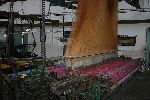
Himroo Factory
Himroo is a superb quality cloth that is fabricated with a fine admixture of cotton and silk threads. Himroo Factory established near the Zaffar Gate in the old Aurangabad Town is a workshop where the famous Himroo hand woven textile materials for which Aurangabad has earned widespread repute are produced. The designs and the patterns that burnish the Himroo fabrics derive insights from the paintings discovered in the caves of Ajanta. At the Himroo Factory of Aurangabad tourists can witness the process of weaving the Himroo clothes and also purchase them at reasonable prices from the factory showroom. Other than that, traditional Paithani Saris, Himroo materials, handloom shawls, Mashru fabrics and silver threads are also available for sale here. It is supposed that Marco Polo had received a gift of a fabric woven in silk and gold threads from the Himroo Factory of Aurangabad. Today, Himroo factory has achieved the eminence of a leading tourist attraction in the Aurangabad city.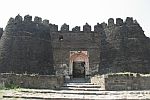
Daulatabad
Known as ‘Deogiri’ in earlier times, Daulatabad is a 14th century fort city positioned approximately 16 kilometers away from Aurangabad. Established by a Yadava King Bhillama V in 1187 AD and renowned as the capital of the Tughlaq dynasty, the present day Daulatabad is particularly celebrated for its historic Daulatabad Fort. The title ‘Daulatabad’ literally means the ‘city of fortune’. The famous Turkic Sultan of Delhi; Muhammad bin Tughlaq had renamed Deogiri as Daulatabad when it came under his realm. The Fort of Daulatabad instituted atop a 200 meters high conical hill is dated back to 12th century AD. This fort can be accessed only through a narrow bridge. Tourists can pay a visit to the Daulatabad Fort from 9:00 am to 6:00 am and Rs 5 are charged as the entry fee here. Other attractions of Daulatabad include the Chand Minar and the Chini Mahal.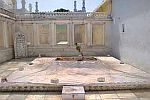
Khuldabad
Khuldabad, situated about 26 kilometers away from Aurangabad in Aurangabad District is a city widely reckoned for housing the tomb of the most notorious Mughal Emperor Aurangzeb. Other prominent tourist destinations of Khuldabad include the tombs of Azam Shah and his wife, Malik Ambar’s Tomb, Burhan ud din’s Mausoleum, Zain ud din Dargah, Nizam ul Mulk Asaf Jah’s Tomb, Khan Jahan’s Lall Bagh, Zar Zari Zar Baksh and Ganj Rawan Ganj Baksh Dargah, Banu Begum’s Makbara and many more.


